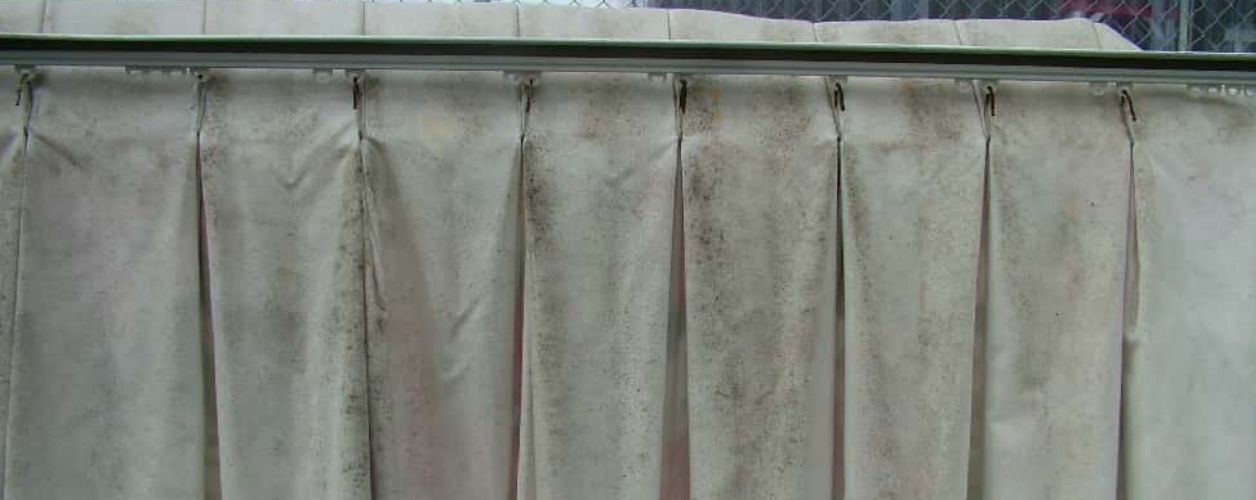How to Remove Stains From Curtains?
Comfort and an aesthetic look are the two main important aspects of every house. Curtains are one of the main accessories that provide privacy and an aesthetic look. Curtains are exposed to water, dust, allergens and dirt. They can easily get stained. Various dirt and dust particles can easily accumulate on the curtains and make them dirty. Water stains, brown stains and mould stains are the most common. There are various methods to remove stains from curtains such as steam cleaning, bleaching and deep cleaning using high-power machines. Apart from this, there are also homemade remedies for removing these stains. To know more in detail about how to remove stains from curtains, read this blog till the end.
Key Facts About Curtain Stains
- Quick Treatment: Treating the stains as soon as possible is important to prevent them from settling and moving deep into the fabric. Treating the stains immediately helps to remove the stains easily and reduces the need for expert help for removing the stains.
- Different Solutions For Different Stains: Various stains require different solutions for removing them. Grease stains can be treated with dish soap and ink stains require rubbing alcohol.
- Preventive Measure Helps: Preventing stains can be done in various ways. You can use curtain liners and also keep the windows closed. You must avoid the entry of dust and dirt and prevent the curtains from getting dirty.
- Treat Different Fabrics Smartly: Delicate fabrics like silk require gentle, specialised cleaning solutions, while more durable materials like polyester can handle stronger detergents. Protein-based stains, like food and blood, need cold water treatment to avoid setting, whereas oil-based stains benefit from pre-treatment with a stain remover.
How To Remove Common Curtain Stains?
Several types of stains can occur on the curtains. Let us check out some common stains on the curtains and how to remove them.
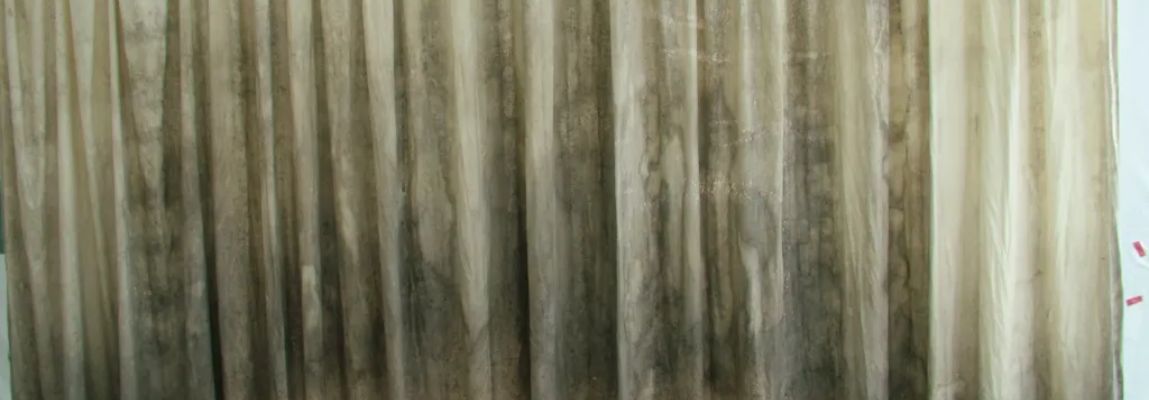
Removing Curtain Stain
Food and Beverage Stains
It includes coffee, tea, wine, juice, soup, sauce and gravy stains.
Coffee stains
Coffee stains are typically dark brown and can leave noticeable marks on curtain fabrics, and surfaces if not cleaned promptly. There are several homemade remedies to remove these stains.
- Immediate actions: You can blot the stains using a cloth. This can remove as much liquid as possible from the fabric.
- Homemade cleaning solutions: There are several homemade cleaning solutions. The best homemade cleaning solution is the mixture of baking soda with water or you can also use the mixture of vinegar and water.
- Commercial stain removers: You can use stain removers specifically made for removing coffee stains. You can follow the product’s instructions to remove the coffee stains.
Tea stains
Tea stains often appear light to dark brown, depending on the tea's strength, and can be stubborn to remove from curtains.
- Quick response techniques: The best quick response technique for removing tea stains is blotting the stains with paper towels to remove excess liquid.
- Soaking and scrubbing tips: Use cold water and vinegar to clean the stained area. Later you can use a soft brush to scrub the area.
Wine stains
Wine stains, especially from red wine, are deep red or purple and can be challenging to eliminate if not treated quickly.
- Red wine vs white wine stains: Red wine stains can be hectic and might require immediate treatment whereas white wine stains can be approached slowly.
- Blotting and rinsing strategies: You can use a clean cloth to blot the stains and then rinse them with cold water. To remove the red wine stains, sprinkle salt or baking soda as it absorbs the liquid before rinsing.
- Stain removal products for wine: Several types of stain removers are available.
Juice stains
Juice stains vary in colour depending on the fruit, ranging from light orange to deep purple, and can set quickly, making them tough to clean.
- Common fruits and their impact: Not every juice is harmful to the curtains but citrus fruits are acidic and can cause discoloration in the curtains. On the other hand, berry juices can also leave dark stains.
- Effective homemade remedies: To remove these tough stains you can use a mixture of lemon juice and baking soda on the stain and later rinse it with cold water.
Sauce and gravy stains
Sauce and gravy stains are usually reddish-brown or beige and can be greasy, making them difficult to remove from curtain fabrics.
- Grease-fighting solutions: You can use a dish soap solution to break down the grease before washing.
- Pre-treatment methods: Use a pre-treatment stain remover and let it sit for a few minutes before laundering. This helps in removing gravy stains.
Grease And Oil Stains
It includes cooking oil, butter, and margarine.
Cooking oil
Cooking oil stains are typically clear or yellowish and can leave a greasy residue on fabrics and surfaces, making them tricky to remove.
- Absorbing excess oil: Use a paper towel to blot the stains slowly.
- Degreasing agents: Firstly you can start by applying a degreasing or a dish soap on the stain and then wash it using water.
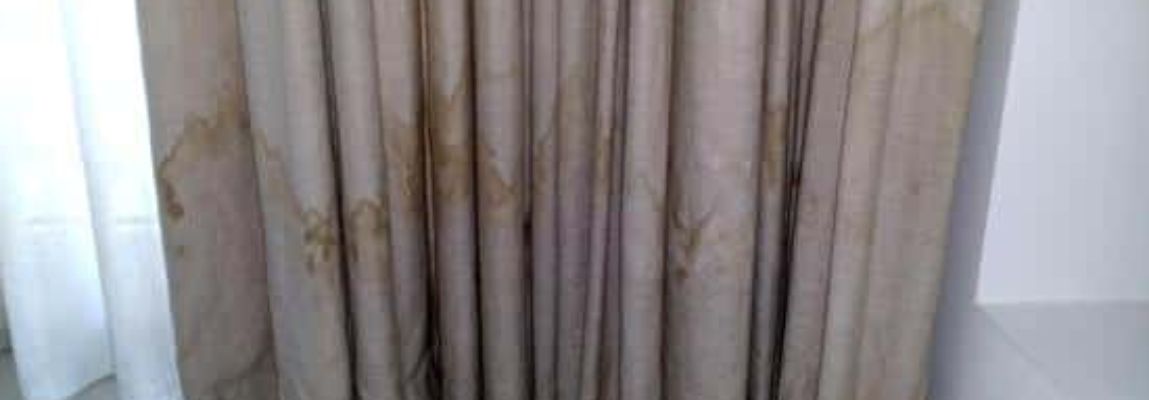
Professional Curtain Stain Removal Techniques
Butter and margarine
Butter stains are pale yellow and greasy. Margarine stains resemble butter stains, with a light yellow colour and greasy texture.
- Freezing and scraping technique: Use an ice pack to freeze the stains and then remove the excess stains with the help of a scrapper. Later apply a stain remover.
- Stain removal sprays: Use good quality commercial stain stain removers.
Ink And Marker Stains
It includes stains from ballpoint pens, gel pens, inkpots, and markers.
Pen ink and inkpot
Ballpoint pen stains are usually blue or black, leaving sharp, ink-based marks. Gel pen stains come in various colours and are more vibrant and pigmented. Inkpots create deep, saturated stains that are challenging to clean.
- Alcohol-based removers: Gently apply rubbing alcohol on a cloth and dab it on the stains until they are removed.
- DIY cleaning mixtures: Prepare a mixture of water and vinegar. It is the best and most effective homemade cleaning solution.
Permanent marker
Marker stains are vivid and bold, with a wide range of colours that can be particularly stubborn.
- Specialised ink removers: Use specialised products to remove permanent marker stains.
- Alternative cleaning hacks: The best alternatives you can use are hairspray and hand sanitisers for removing the stains.
Pet Stains
It includes urine, stool, hair and dander stains.
Urine
Urine stains are typically light yellow and can cause unpleasant odours and discolouration. Stool stains can range from light brown to dark brown.
- Neutralising odours: Use vinegar after blotting the stains.
- Enzyme-based cleaners: Several enzyme-based cleaners are used. They break the proteins of the urine stains effectively.
Pet hair and dander
Hair and dander stains are generally not visible as stains but can accumulate and leave behind a fine layer of dust or oil on surfaces.
- Lint rollers and vacuum attachments: Lint rollers and vacuum attachments are used.
- Anti-static sprays: These are the sprays useful in reducing hair and dander buildup.
Biological Stains
It includes blood stains and vomit.
Blood stains
Blood stains are typically dark red or brown and can be difficult to remove.
- Cold water rinsing: To prevent the stains from setting, rinse the stains from cold water.
- Enzymatic cleaners: Enzymatic cleaners break down the proteins in the blood stains.
Vomit
Vomit stains vary in colour but are often yellowish or brownish.
- Immediate clean-up steps: The first action to be taken during vomiting is to remove as much vomit as possible using a cloth or a paper towel.
- Deep cleaning solutions: For deep cleaning of the stains, you can use a solution of baking soda and water. This also helps in neutralising the odours.
Environmental Stains
It includes mould, mildew, dust, dirt, and water stains.
Mould and mildew
Mould and mildew stains are usually dark green, black, or grey.
- Identifying mould and mildew: You can identify mould and mildew by their look. Mould is usually black or green whereas mildew is grey.
- Cleaning agents and preventive measures: A commercial mould cleaner is used to remove or prevent recurrence. You can also use a mixture of water and vinegar.
Dust and dirt
Dust and dirt stains are typically grey or brown and can embed deeply into fabrics.
- Regular cleaning routines: Dusting your curtains regularly once a week is important in keeping them clean and maintained.
- Effective dusting techniques: Before you vacuum the curtains, dust them thoroughly to lose the dust.
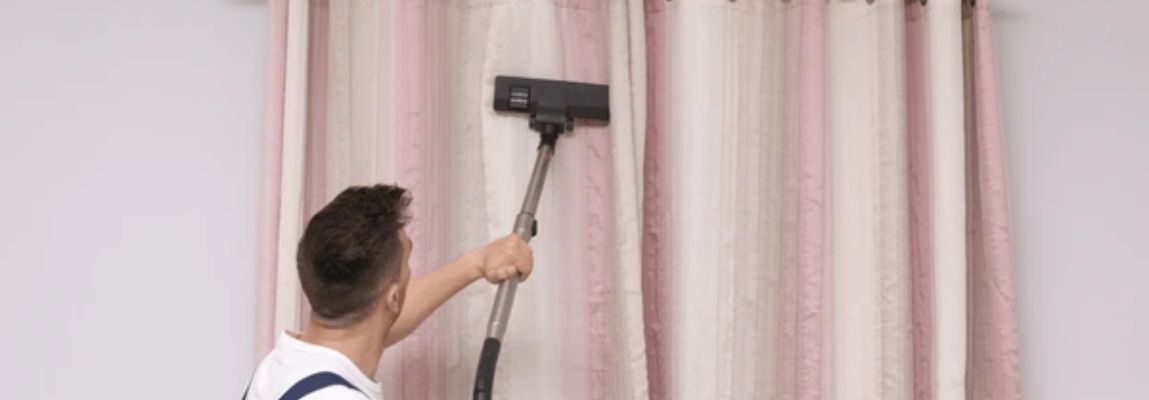
Curtain Cleaning By Professional Cleaner
Water stains
Water stains often appear as light, cloudy marks with white or yellowish edges, and can leave unsightly rings on wood, fabric,
- Instant actions: You can blot the area using a clean cloth.
- Ring removal strategy: The ring removal strategy is done by applying a mixture of vinegar and water to the stains and later blotting them gently to remove the water rings.
Curtain Fabrics: How to Remove Stains From Curtains
Some fabrics are so delicate and require extra attention and care. To learn more about proper cleaning techniques, check out our guide on how to clean curtains. The curtains that require special care include::
Silk curtains
- Blotting the stains: To remove the excess liquid from the silk curtains, it is important to blot them with a clean cloth. Make sure you don’t push the stain further into the fabric.
- Use cold water: Use a clean cloth damped in cold water and gently dab the stains.
- Using mild detergent solution: Mix a small amount of mild detergent with cold water and slowly apply this solution to the stain.
- Rinse and dry: Use cold water for rinsing the area and later blot dry with a clean towel.
Velvet curtains
- Blot the stains: Start by blotting the stains gently using a clean, dry cloth.
- Vacuuming: To remove the loose dirt and debris use an upholstery attachment.
- Velvet cleaner: There are specific types of velvet cleaners by different manufacturers. You can choose the best one and apply it to the curtains.
- Steam clean: You can use a handheld steamer to refresh the pile but avoid direct contact with the fabric.
Lace curtains
- Blotting: Gently blot the stains using a white cloth.
- Soak in cold water: You can fill a basin with cold water and add a mild detergent.
- Rinse and dry: Use clean cold water to rinse the curtains and lay the lace flat on a clean towel to air dry.
Cleaning The Entire Curtain Vs Only The Stained Area
One of the most commonly asked questions is whether to clean the entire curtain or just the stained area. This generally depends on various factors such as the type of fabric, type of stain and the overall condition of the curtains.
When only the stained area cleaning is better
- Small stains: In case of small stains, spot cleaning can be helpful and might not require a full wash.
- Delicate fabrics: Delicate fabrics such as silk and lace can get easily torn. Spot cleaning prevents the stains from getting deep into the fabrics and damaging them.
- New curtains: If you have new curtains with less dirt and dust, only cleaning the stained area is sufficient.
Importance of spot cleaning
- It helps in preserving the fabric of the curtains. Frequent deep cleaning can damage the curtains.
- Spot cleaning will also save time and effort compared to washing the entire curtain.
- The risk of colour fading decreases as no harsh chemicals are used in this process.
When it’s better to clean the entire curtain
- Multiple stains: You must clean the curtain in case of tough stains.
- Allergy concerns: Dust mites and pet dander can cause health issues. To save yourself from these allergens, deep cleaning is the best option.
- Seasonal cleaning: To prolong the lifespan of the curtains, cleaning them seasonally or annually is important.
Importance of Full cleaning
- You can revive the fabric and make it look fresher by fully cleaning the curtains.
- It prevents mould and mildew from getting settled on them during humid conditions.
- It thoroughly removes the dust and allergens.
How To Choose Between Curtain Steam Cleaning And Dry Cleaning?
Before choosing between curtain steam and dry cleaning, consider many aspects.
Curtain Dry Cleaning
Advantages of services
- It remove deep and oily stains which might not be removed with steam cleaning services.
- It is useful in safely cleaning delicate fabrics such as velvet, silk and lace which can be damaged if cleaned using water or steam.
- There is no risk of shrinkage in dry cleaning as no water is used in this method.
Limitations
- The cost of curtain dry cleaning can be more expensive than steam cleaning and can increase as the size of the curtains increases.
- Sometimes dry cleaners cannot handle and transport the large curtains.
- Many chemical solvents are used in dry cleaning which can damage the fabric of the curtains.
Curtain Steam Cleaning
Advantages of services
- Curtain steam cleaning helps remove surface stains. It helps in dissolving stains with the help of high temperature and pressure.
- Steam cleaning removes bacteria and germs. So it is the best option for allergens.
- It is good for delicate fabrics as it is gentle and does not cause any harm as no chemicals are used in this process.
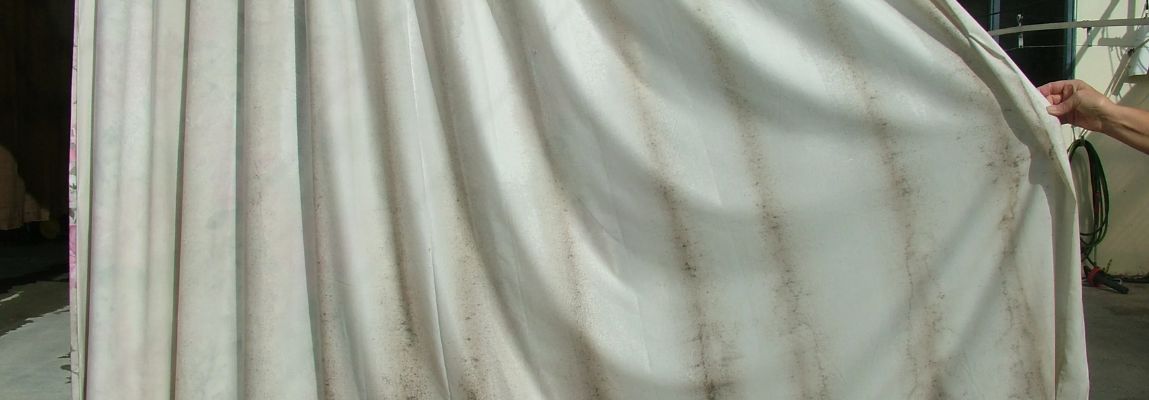
Curtain Stain Cleaning
- Steam cleaning is not so effective in cleaning the deep stains that are set deep in the curtains.
- Steam cleaning might not clean the fabrics prone to water damage and shrinkage.
Tips For Preparing To Remove Curtain Stains
- Identifying the type of stain: There are various types of stains such as oil-based, water-based, protein-based and others. Depending on the type of stain you can start cleaning the curtains.
- Blot the stains: Make sure to take immediate action. You can blot the stains to prevent them from moving deep into the fabric.
- Use pre-treatment solutions: Several types of pre-treatment solutions can be used such as mild detergent solution, baking soda paste and commercial stain removers.
- Testing on inconspicuous areas: Before you start to remove the stains from the entire curtains, make sure to test them on small patches of the curtains.
DIY vs Professional Curtain Cleaning For Stains
When choosing between DIY and professional curtain cleaning services, several factors need to be considered such as the type of fabrics and the severity of the stains. Here is a quick comparison between DIY and professional curtain cleaning to help you understand how to remove stains from curtains:
DIY Curtain Cleaning
Advantages
- It is a cost-effective process as you don’t have to hire professionals for cleaning.
- You can clean the curtain according to your convenience and time. This makes it an excellent choice for you.
- You can select the products and techniques according to your curtains.
Disadvantages
- Some curtains can be costly and lack of experience and knowledge can damage the curtains while cleaning.
- Some stains can be tough and might take a lot of time to be removed so be prepared to put in some time and effort for cleaning them.
- There are several ways to clean different types of curtains and you might have to learn them to clean them thoroughly.
Professional Curtain Cleaning
Advantages
- Professionals have expertise that guarantees that your curtains will be taken proper care while cleaning and all the stains will be removed.
- Professional cleaners also take care of fabric safety. This ensures that your curtains are not damaged while cleaning.
- They use top-quality tools and techniques. This ensures they clean the curtains quickly and thoroughly.
Disadvantages
- Professional services can be costly. For a detailed overview, check out the Curtain Cleaning Cost in Top Cities in Australia to help you budget and decide if DIY methods might be more suitable for you.
- Expert cleaners have their schedule so you must be prepared to be available according to their timetable.
Curtain Stain Prevention Tips
- Spot cleaning: Spot cleaning is one of the best ways to prevent the stains from getting deep into the fabric and making it a permanent stain.
- Regular cleaning: Cleaning your curtains regularly is important to avoid dirt settling into them.
- Use a lint roller: A lint roller is useful in removing hairs and other stuff from the curtains.
- Mild laundry detergent: Always use a mild laundry detergent while cleaning your curtains. This will help in removing stains and also prevent curtain damage.
Conclusion
Removing stains from curtains requires quick action and proper cleaning solutions. Addressing the stains promptly and using the right techniques help remove all kinds of stains from the curtains. You can hire professionals or use homemade solutions for cleaning the curtains at home. Always use preventive methods to prevent the curtains from getting stained and damaged.

